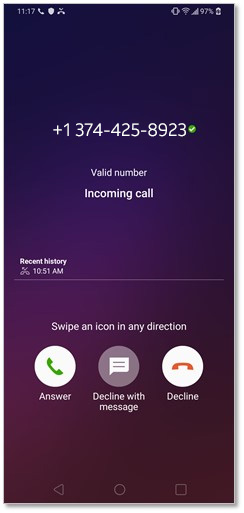

For example, some off-campus phones may have the feature Anonymous Call Rejection (ACR) installed.
Incoming caller id not showing code#
Override Feature Access Code and Anonymous Call Reject: Both options include a feature access code that lets you, when necessary, override your chosen setting for a particular call. If you are not sure what your current outgoing Caller ID setting is, please call our Help Desk at 5-HELP. The person you call can see your telephone number.

You must use an override feature access code to keep this information from being sent, see below.) Calls made on campus will always display Caller ID information.

With this option, the Stanford telephone system does NOT transmit the telephone number when you make an off-campus call. Caller ID Blocked keeps a telephone number private.How does outgoing Caller ID work?Īt Stanford, users have two options for outgoing Caller ID: "Blocked" or "Unblocked." Incoming Caller ID interacts with Caller Line Blocking, so what is (or is not) displayed is determined by the person placing the call. (Calls from off-campus, however, do not show the caller's name.) If an ON-campus caller has not blocked the display of information, the LCD display screen will show the caller's five-digit campus telephone number and the caller's name, if available.If an OFF-campus caller has not blocked the display of information, the LCD display screen will show the caller's seven- or ten-digit telephone number.How incoming Caller ID works depends on the Caller ID settings for the incoming call: The feature is divided into two parts: incoming Caller ID, which lets you see the telephone number for calls coming into your phone, and outgoing Caller ID, which lets people you call see your telephone number. The Caller ID feature is available for all Stanford telephones. Caller ID is a feature that lets the call recipient view the caller's telephone number before answering the call. "Select which handset rings and receives cellular calls".When someone places a telephone call, the telephone system transmits information about the call (including the phone number from which the person is calling) across the telephone network. The unit which is not selected to ring for cellular calls does not announce caller information, change the.The ringer volume for cellular line is turned off, adjust the ringer volume.The ring as cell mode is set to “ On (without Talking CID) ”.The Talking Caller ID feature is turned off.Your unit does not announce caller information while the other devices such as headset or handsets are engaged in.Move the handset closer to the base unit.The ringer volume is turned off, adjust the ringer volume.Refer to "How to select a different ring setting". Ring or later, the number of rings for the answering system is set to “ 2 rings ”. Depending on your phone service provider, the unit may display or announce the caller’s information at the 2nd.Contact your DSL/ADSL provider for details. If you use a DSL/ADSL service, we recommend connecting a DSL/ADSL filter between the base unit and the telephone line jack.If your unit is connected to any additional telephone equipment such as a Caller ID box or cordless telephone line jack, plug the unit directly into the wall jack.Plug the base unit into a different telephone line plug and test again.If they are continue with troubleshooting.



 0 kommentar(er)
0 kommentar(er)
